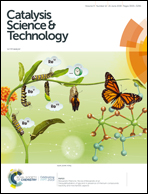Sn-doped Pt catalyst supported on hierarchical porous ZSM-5 for the liquid-phase hydrogenation of cinnamaldehyde
Abstract
A 3 wt% Pt catalyst supported on hierarchical porous ZSM-5 (HPZSM-5) derived from the alkali desilication of ZSM-5 with Si/Al2 ratio of 170, termed as 3Pt/HPZSM-5, was employed in the liquid-phase selective hydrogenation of cinnamaldehyde (CAL) to cinnamyl alcohol (COL). This process yielded higher CAL conversion as compared to that yielded when a conventional ZSM-5 support was used. After Sn was doped with a Pt/Sn weight ratio of 60, the 3Pt0.05Sn/HPZSM-5 catalyst was proven to be more efficient for the selective hydrogenation of CAL to COL with further improved CAL conversion, although the COL selectivity was marginally less but still comparable. As a result, both CAL conversion and COL yield over the 3Pt0.05Sn/HPZSM-5 catalyst were remarkably improved in contrast with those achieved with the Pt catalyst supported on HPZSM-5 or ZSM-5. A series of characterizations were employed to interpret the influence of alkali desilication and Sn promotion. It was revealed that the surface acidity of ZSM-5 was modified and the interaction between Pt and support became stronger, although the strong Brønsted acid sites almost vanished after partial desilication. Moreover, electron donation was observed from Sn to Pt such that the surface electronic properties of Pt nanoparticles were modulated. The surface geometry of Pt catalysts was also adjusted after Sn was doped. Based on the FT-IR spectroscopic results using CO as the probe molecule, besides Pt(111), even Pt(100) facets were exposed on the surface.



 Please wait while we load your content...
Please wait while we load your content...